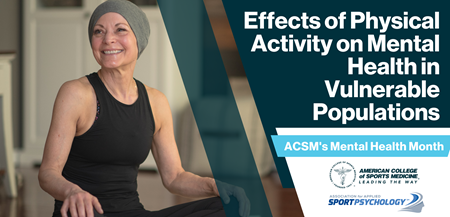Jordan Taylor, MPH |
May
16, 2022
 If you or someone you know is managing a mental illness, then you or they are not alone. Many Americans struggle with mental illnesses. Almost one in five adults live with a mental illness (52.9 million in 2020). Mental illness is defined by the National Institute of Mental Health as a mental, behavioral or emotional disorder that can vary in impact from mild to severe. Mental health problems are equal opportunity, regardless of your race, gender, age, income or education, mental illness can affect all of us. Exercise has been shown to positively affect mood, quality of life and overall mental health. This can include walking around the block, giving your body a good stretch or even doing some pushups or squats. The intensity can vary as well—just the act of movement can have profound effects!
If you or someone you know is managing a mental illness, then you or they are not alone. Many Americans struggle with mental illnesses. Almost one in five adults live with a mental illness (52.9 million in 2020). Mental illness is defined by the National Institute of Mental Health as a mental, behavioral or emotional disorder that can vary in impact from mild to severe. Mental health problems are equal opportunity, regardless of your race, gender, age, income or education, mental illness can affect all of us. Exercise has been shown to positively affect mood, quality of life and overall mental health. This can include walking around the block, giving your body a good stretch or even doing some pushups or squats. The intensity can vary as well—just the act of movement can have profound effects!
Certain vulnerable populations are at even greater risk for having poor mental health or mental illness. Pregnant women, cancer patients, inmates and substance users are groups that are likely to have mental health struggles and lower levels of physical activity. These groups do not often receive the attention that is warranted.
The World Health Organization (WHO) acknowledges that 10-16% of pregnant women and 13-20% of postpartum women experience mental disorders. Pregnant women can suffer from mental health issues including depression, anxiety or bipolar disorder. When these illnesses are severe enough, they can lead to negative pregnancy outcomes. These can be a result of low social support, a history of depression or anxiety, life stress, unintended pregnancy or intimate partner violence. Pregnant women can improve their mental health by adding exercise into their routine. Exercise has also been shown to lower rates of antenatal depression and anxiety.
The number of cancer patients dealing with psychological disorders is high, affecting approximately 33%. Rates of major depressive disorder in cancer patients are thought to be up to three times as high as the general population. Cancer patients can experience depressive symptoms because of their diagnosis. Life may look bleak, or patients might be overcome with despair following this traumatic news. For these reasons it is even more important that their mental health needs are met. Just participating in leisure time physical activity has been shown to increase well-being, mental health and overall outlook on life.
Prison inmates may also be more prone to dealing with mental health struggles because of their incarceration. High rates of mental illness are seen in this population, with a study showing that 64% of jail inmates, 54% of state prisoners and 45% of federal prisoners reporting mental health concerns. A survey showed that structured exercise within the prison population reduced rates of depression, anxiety and hostility scores.
Unfortunately, substance use and mental disorders can go hand and hand. Numerous national surveys found that about half of those who abuse substances will also experience a mental illness during their lives, and vice versa. There is a high co-occurrence of substance use and anxiety, depression, bipolar disorder and borderline personality disorder. This overlap is concerning. Research suggests that physical activity programs and even mind-body programs can positively effect depression, anxiety, stress and even cravings.
If you don’t know where to start, getting the heart pumping doing some aerobic activity and resistance exercise you enjoy has been shown to be associated with lowered depression and anxiety levels. Jogging, swimming, cycling, walking, gardening, lifting weights, playing sports and dancing can all have an impact on improving your mental health. ACSM, the CDC and WHO recommend cancer patients, pregnant women and general population adults get at least 150 minutes of moderate-intensity aerobic physical activity each week. Aerobic activity has also been shown to reduce drug cravings, depression, anxiety and increase drug withdrawal rate among drug users. Lastly, prison inmates should be getting one hour of physical activity a day, five days per week. Most importantly, this should include outdoor recreation and sport activities, which can help to eliminate feelings of hopelessness and increase social opportunities which can lead to better mental health. Mind-body exercises such as yoga and meditation can have profound effects on our mental states. In addition to the benefits of the yoga movements that include creating a more positive mood and increasing endorphins, yoga can strengthen connections in your brain that allow you to have better memory, attention, awareness, thought and language. Yoga can also be an effective long-term remedy for depression and anxiety.
During Mental Health Awareness Month, we should take some time to remember how life stressors can affect us all differently. Take some time for self-care and to care for and support one another. Keep in mind those who are in challenging situations and how their mental health can be affected. Even though someone may not feel comfortable talking about their mental health, doesn’t mean they aren’t facing challenges.
Access Mental Health Resources
 Jordan Taylor, MPH, is a graduate from The University of Memphis with his bachelor’s in psychology and master’s in public health. He is a member of the ACSM Leadership & Diversity Training Program and currently works as a fitness coach in Memphis, TN. Jordan has a passion for helping people achieve their best selves physically, emotionally, and mentally through health and fitness.
Jordan Taylor, MPH, is a graduate from The University of Memphis with his bachelor’s in psychology and master’s in public health. He is a member of the ACSM Leadership & Diversity Training Program and currently works as a fitness coach in Memphis, TN. Jordan has a passion for helping people achieve their best selves physically, emotionally, and mentally through health and fitness.